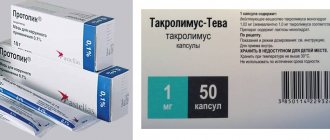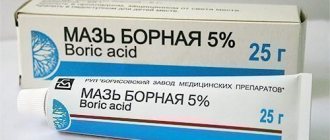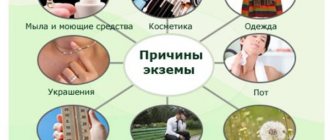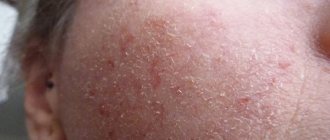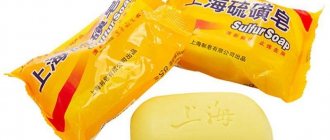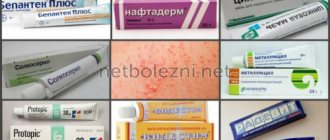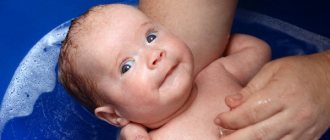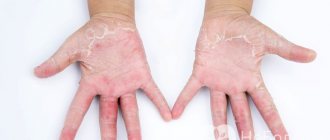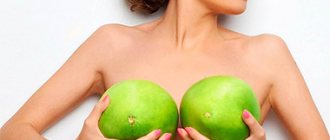Elderly people very often experience various diseases of the veins of the lower extremities. One of these pathologies is varicose eczema, which appears due to impaired blood flow in the veins. Most often, the disease affects females. If treatment is not started in time, eczema can become chronic and periodically worsen.
Symptoms
Skin peeling characteristic of eczema
This term refers to a skin condition that develops when the pressure in the veins of the legs (venous pressure) increases.
You can also hear such related names for this disease as gravitational eczema, congestive eczema or congestive dermatitis and venous eczema.
The affected areas of the skin usually become red. You may also notice that your skin becomes scaly or begins to peel. Varicose eczema is characterized by the appearance of dirty brown spots with discoloration.
As complications progress, blisters or ulcers may develop and the skin may become rough. Itching, which can eventually become painful, is one of the symptoms that brings terrible discomfort to the patient.
Other symptoms may occur during complications if a person ignores treatment. They include:
- rough skin with the formation of crusts or scales;
- the appearance of folds on the affected area (dark brown);
- the appearance of cracks in the skin;
- the appearance of ulcers and abscesses.
The disease usually develops on the lower extremities, mainly on the lower legs. Without treatment, it is possible that minor inflammation may spread to nearby tissue.
When this happens, treatment becomes even more difficult. It is likely that bacteria can penetrate into the resulting ulcers, which will only worsen the general condition.
Most people who observe this disease in their friends or relatives are wondering whether eczema is transmitted? In fact, you don’t have to worry about this issue, because although the disease looks terrifying and is difficult to cure, it is not transmitted from person to person, like weeping eczema.
How the disease develops
Varicose eczema mainly affects older people. Those at greatest risk are those who have varicose veins or have had surgery during a thrombosis.
Varicose eczema occurs on the legs when the pressure in the veins increases. High blood pressure is associated with weakened valves in the veins, which not only impedes blood flow, but also causes blood to flow backwards. Thus, the lower limbs are full of blood, which means the pressure will increase.
Increased pressure in the veins leads to swelling of the legs. Fluid from the blood cells in the lower extremities leaks under the skin. The result of this is inflammation of the skin and then the development of eczema.
Useful tips for varicose dermatitis
General recommendations from doctors include advice on food choice and daily routine. Staying in one position for a long time is harmful, just like walking long distances. Tight shoes and synthetics are prohibited; clothing and shoes must be comfortable, breathable, and not cause discomfort in sore feet.
Compression hosiery helps normalize blood circulation in the lower extremities. The degree of compression is prescribed by the doctor individually.
The table should be dominated by dishes with plenty of vitamins, microelements and protein. Hot and spicy dishes, alcohol should be excluded, provoke local allergies and skin reactions.
Hirudotherapy is useful because leeches thin the blood, improving its circulation through vessels of different sizes. However, not all patients benefit from the procedure; it can only be performed in an equipped office.
Reasons for appearance
Varicose veins on the leg
The cause of the disease is varicose veins. As a rule, it appears in people who are elderly (over 65 years old).
However, there is also a chance of developing varicose eczema at a younger age and even during adolescence.
The disease can affect a young body if a person has suffered diseases such as varicose veins, phlebitis or deep vein thrombosis.
It has been found that women have a higher risk of developing varicose eczema due to hormonal changes during pregnancy.
Therefore, varicose eczema occurs quite often in pregnant women.
What treatments are used
The key to treating stasis dermatitis (varicose eczema) is to control symptoms. The first step during treatment will be to reduce the cause of the swelling.
However, the clinic may suggest that the patient undergo surgery to correct varicose veins, before which, however, numerous procedures must be performed to remove excess fluid in the legs.
An effective way to relieve swelling is to keep your legs elevated. Light exercise, such as walking short distances, can also help promote normal blood circulation.
Basic recommendations from doctors:
- Avoid skin trauma;
- Place your feet on a pouf or stool when sitting (gravity will help the blood flow back up your veins);
- Lead an active lifestyle and take regular walks (when the muscles in the legs are active, they help push the blood back in the veins);
- Avoid standing on your feet for long periods of time (this position puts even more pressure on the veins);
- Make sure that the skin does not become too dry, use moisturizing creams (emollients) regularly;
- Apply steroid medications to your skin.
Treatment may consist of topical steroid creams and compression stockings to help distribute the accumulated fluid throughout the limb.
Preventive measures
To ensure a quick recovery and prevent relapse of the disease, you should adjust your diet. First of all, it should support the functioning of the heart muscle. You need to stop smoking and drinking alcohol, fried and smoked foods. Be sure to drink plenty of fluids (up to two liters per day) so that the blood does not thicken and blood clots do not form.
To reduce sweating, it is better to choose a wardrobe made from natural materials. Try to change your set of clothes more often to prevent fungi and other infections from growing on them and at the same time avoid getting them on wounds. Always keep your feet clean and disinfect the skin, as an infection that gets into eczema quickly reaches the subcutaneous layer, causing recurrent diseases.
You should spend more time outdoors. Appropriate physical procedures also contribute to prevention.
Diet for eczema for adults and children
Drugs to relieve symptoms
Topical steroids work by reducing skin inflammation in varicose eczema on the legs. The steroid is used as an ointment rather than a cream if the skin is very dry.
Topical steroids are usually used once a day (sometimes twice a day - if your doctor advises). Apply a small amount of ointment in a thin layer to areas of the skin that are inflamed. Gently rub the cream or ointment into the skin until it disappears. Wash your hands afterwards.
In order to relieve irritating itching, specialists will prescribe the following antiallergic medications:
- Clemastine;
- Loratadine;
- Cetirizine;
- Promethazine;
- Erius.
Nowadays, in order to reduce symptoms, a large variety of ointments have been developed. Ointments against varicose eczema are an excellent remedy in the fight against the disease.
Popular ointments against varicose eczema:
- Radevit - apply a thin layer to the affected area until absorbed. Heals cracks and relieves inflammation;
- Skin cap – relieves itching, cools, promotes rapid healing;
- Flucinar – relieves itching and dry skin. Apply gently to the affected area of the leg;
- Exoderil – relieves inflammation, promotes healing;
- Aurobin - used at the initial stage of the disease. Promotes healing of cracks.
All ointments are applied in a thin layer to the affected area of the limb until completely absorbed. Clean the affected area with plain water and dry well.
Then apply the ointment to the affected areas of the skin, followed by a gentle massage with your fingertips so that it is completely absorbed into the skin. The ointment should be applied every 24 hours and should not be washed off until 7 hours after application. Prices range from 130 to 260 rubles.
Prevention
The disease is difficult to cure, but it can be avoided if you follow simple recommendations:
- Do not wear high-heeled shoes all the time. The optimal heel height for daily walking should be no more than 4 cm. Shoe models should be comfortable and match the size of the foot.
- In the evening, rest with your legs elevated to speed up the flow of blood from bottom to top.
- Moisturize your skin after showering. You can use cream, lotion, water-based emulsion, cosmetic oil.
- “Load” your legs with moderate exercises. Walking has a beneficial effect on the condition of blood vessels.
- Drink water (2 liters per day) to thin the blood and prevent stagnation in the blood vessels.
- Use hypoallergenic skin care cosmetics, you can buy a children's series.
- Periodically take vitamins and immunomodulators.
Treatment of the disease at home
Treatment with folk remedies came to us from our ancestors and is popular in the modern world. Without leaving home, you can treat varicose or weeping eczema using various herbs.
Natural treatment involves the use of medicinal plants. Herbal treatment involves regular use of herbal or organic creams on the affected areas.
This can be combined with a hypoallergenic moisturizer that hydrates the skin and keeps it balanced.
Here are some common herbs used to treat the condition:
Aloe vera
Aloe vera is currently used to treat a variety of skin conditions, including dryness and burns.
The plant has been in use for centuries. Aloe vera contains complex sugars known as polysaccharides, which naturally moisturize the skin.
This increases oxygen availability to skin cells and also helps kill bacteria. Aloe vera helps soothe irritated skin and prevent future infections. Thus, the plant can be considered as an effective herbal treatment for eczema.
You can find many topical products containing aloe vera. However, the best source is the plant itself. You can directly cut the leaf and apply the thick liquid of the plant directly to the skin. Aloe vera helps in reducing the symptoms of eczema and improves the overall quality of the skin.
Chamomile
Chamomile is considered a popular medicinal plant for skin conditions.
Chamomile contains a compound called alpha-bisabolol (has anti-inflammatory and anti-itch ingredients).
Chamomile is available as an herb or essential oil. Chamomile flowers can be added to a warm bath, which helps soothe inflammation and itching.
Tea tree oil
Tea tree oil or Emu oil can be applied regularly to the affected areas throughout the day as it helps relieve swelling and dryness.
This method is effectively used for herbal treatment of varicose eczema. Helps soothe itchy skin.
Turmeric
Turmeric is a powerful herbal plant that is widely used in cooking. In addition, it has high medicinal value. Turmeric has an active ingredient called curcumin, which is an anti-inflammatory agent.
This helps reduce histamine production in the body. The antioxidant properties of turmeric help the skin maintain a youthful appearance. You can apply turmeric paste on the affected areas and then wash it off with warm water.
About eczema and dermatitis (video)
Traditional medicine recipes
Medicinal herbs and tinctures are used in the treatment of various dermatological diseases. This treatment will complement traditional medications. Effective against dermatitis: grape leaves, chamomile, oak bark, calendula, chestnut - these plants heal wounds, kill germs, relieve inflammation. Various oils help well: almond, wheat, coconut. The oil can be applied to clean skin.
One of the effective ointment recipes is not difficult to prepare. You need to take 1 tbsp. burdock, chamomile, fireweed and mix with 1 tbsp. butter (82%). Simmer the pulp in a water bath, then mix it with glycerin and lubricate the affected areas.
